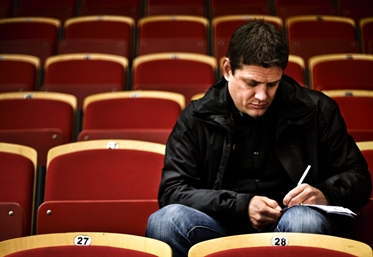Finding the next top talent
Finding the next top talent
Detroit scout shares insight on loneliest job in hockey

 Håkan Andersson has been a Detroit Red Wings scout since 1990. Photo: Jimmy Croona
Håkan Andersson has been a Detroit Red Wings scout since 1990. Photo: Jimmy Croona
It's a lifestyle that Detroit chief of European scouting Håkan Andersson knows well, having been a constant presence in ice rinks across the continent for over twenty years.
Ahead of the 2013 IIHF Ice Hockey U18 World Championship, the last major tournament for NHL prospects before the draft, he sat down to IIHF.com to discuss his career.
How important is the U18 World Championship on the scouting calendar?
It’s very important, without a doubt. This is the last time you will have a chance to see those guys that you will be drafting two months later, so it’s very important. Every year, there’s always players in Europe who come up and impress in this tournament. We got a couple of players to watch out for, couple of Russians, guys in Chelyabinsk, couple of Finns and Swedes too. We have three or four European scouts and more guys coming from North America too.
For someone who isn't familiar with the process of scouting players, how would you describe a typical day in the scouting business?
I don’t know if there is a typical day, I’m either at home planning my schedule, including booking hotels, travel. I’m a European scout so I spend a lot of time looking at the different league schedules. Anytime I’m at a game in Sweden, Finland, or Russia, there’s also a game going on at the same time that I could have been at.
How many games do you average per year?
I’d say just over 200.
Continue readingWhat do you look for during a game that the casual fan might miss?
During a game for example the fan typically watches the puck most of the time, wherever the puck is that’s what they see, be it a nice shot or save or whatever. For me I also pay attention to what’s happening away from the puck, how does a player react after a bad shift, or how they react on the bench after a good shift.
And also other details, like how does he play the 1-on-1 in front of the net? A lot of times the regular fan will look at who’s shooting the puck, while I’m looking at the defenceman to see how he reacts to the play or where his position is relative to the puck and the opposing player. There are a million different things that are part of the game that teams teach players that fans don’t see, these are what I look for.
Does it happen often that you'll go to scout one player then someone else catches your attention?
I would say that it doesn’t happen a lot. But it has happened, actually a couple of players in Detroit now were discovered this way.
Which players?
The biggest one would have been (Pavel) Datsyuk. I went out to see Dmitri Kalinin, who ended up playing in Buffalo for many years. His team was playing in Yekaterinburg, and they had a small centreman who was on the puck a lot and made some good plays but was also very good defensively, a very smart player. He caught my eye and I was kind of waiting to see if he made the World junior team, and then when he didn’t I went to see him a couple of more times and he showed that, well, he was Datsyuk (laughs).
Jonathan Ericsson was another one. He was playing, not in the highest junior league in Sweden but in a secondary league, I went to that game to see a forward that was scoring a lot in the league. The game happened to be against Ericsson’s team and the guy was ok but the player that I really liked was on the other team: a defenceman that was really mobile, was big and nobody could get around him. That was Ericsson (now in his 6th NHL season).
When scouting a player, do you look to see if they would be a specific fit for the Detroit system?
Our boss Ken Holland was in his first year as chief of scouting 23 years ago when I started scouting for Detroit. We had a lot of discussions with the scouting group and management group about what our game was like and what we wanted the team to be like. But I think that most of all we look at who has the best chance of making the NHL. Because if we end up with someone we don’t like or who doesn’t fit our system, he is still an NHL-caliber player and we can just trade him. So I think our philosophy is to pick the best player. It’s so hard for a player to make the NHL, and from being drafted to playing for Detroit is almost always a minimum of three to four years, so it’s hard to try and determine if he will fit into the system at that age.
When was the first time you became seriously involved with picking a player at the NHL draft?
I think the first one was Tomas Holmström, he was a guy that nobody else had seen, and back then the draft was eleven or twelve rounds. So we were getting into the late rounds and at that point Ken was more or less asking if anybody had a name that they believed in. And I put my hand up and had this Holmström character. A little bit of an odd guy, not the best skater in the world, but he had some things that I liked a lot. So Ken said let’s grab him and see what happens. Obviously with four Stanley Cups he’s gone beyond our expectations.
With a team as consistently good as Detroit has been, does it get annoying sometimes when you almost never get a top ten pick?
Oh, without a doubt (laughs). The last one I can really think of is Erik Karlsson, I really early on felt that this little kid could be a star in the NHL, but I just hoped that people wouldn’t like him, because there was talk about him being small and he was taking a lot of what people felt were stupid chances with the puck. But it was part of his learning process, obviously he made some mistakes but he turned out to be a helluva player, and I was thinking “Oh I hope he doesn’t play as good as I think he is” so we’d have a shot at him. But he ended up going 15th to Ottawa. Obviously if you redid that draft today he’d be a top five pick.
Are there any big differences between North American and European prospects regarding their development?
Well I think the one big difference is that the North Americans are usually more advanced physically, they’re without a doubt much bigger at 17 and 18 than the Europeans. Skill-wise I don’t know if they have an edge, competitiveness maybe a little bit, but that’s more of an individual thing.
Have there been any big changes in how players are scouted from when you started out? For example, are players getting scouted at a younger age now than before?
No, it's actually the opposite with me. In Sweden we have a tournament for 15, 16 year olds from different states in Sweden that’s shown on TV. I followed that closely the first couple of years, but then I realized that the difference between 16 and 18 was big. So I payed less attention to it. Agents fight like cats and dogs over kids then two years later then don’t get drafted, which is a shame.
Are there any countries outside the top four or five that scouts should be checking out in the future?
Sweden has been doing great, but outside the top nations Norway’s a country to keep an eye on, they love winter sports and are coming along. Denmark as well has a couple of guys in the NHL, and there’s more players coming out of there. Switzerland has some players, and scouts need to be there. Germany too. In all these countries it’s all about the individual, that if he wants to play and has a rink close by you gotta watch out for him.
How many players do you put on prospect list?
Around 70, it changes constantly leading up to the last game played. We have a deadline for our final list, around May 1st. After that there are very few changes but up until then it changes every week. It’s supposed to change a lot too because if you think you can walk into the draft and pick out the best guys in the right order then you’re dreaming.
What would you say is the toughest position to scout?
The position that I know the least about is goalies, it takes such a long time for them to peak, and you have to look at a kid and try to project how he will be 10-13 years from now. Viktor Fasth (Anaheim) is a great example, he wasn’t on anyone’s radar until he turned 28. That tells everything and is a good example that if you love something don’t give up.
Back to Overview




















































